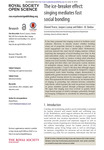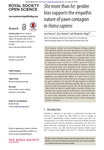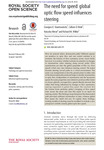Search
Now showing items 1-10 of 13
Strong biomechanical constraints on young children’s mental imagery of hands
(2014)
Mental rotation (MR) of body parts is a useful paradigm to investigate how people manipulate mental imagery related to body schema. It has been documented that adult participants use ‘motor imagery’ for MR of hands: a ...
Greater magnocellular saccadic suppression in high versus low autistic tendency suggests a causal path to local perceptual style
(The Royal Society, 2015)
Saccadic suppression—the reduction of visual sensitivity during rapid eye movements—has previously been proposed to reflect a specific suppression of the magnocellular visual system, with the initial neural site of that ...
Teaching in hunter– gatherer infancy
(2016)
A debate exists as to whether teaching is part of human nature and central to understanding culture or whether it is a recent invention of Western, Educated, Industrial, Rich, Democratic cultures. Some social–cultural ...
Information use by humans during dynamic route choice in virtual crowd evacuations
(2015)
We conducted a computer-based experiment with over 450 human participants and used a Bayesian model selection approach to explore dynamic exit route choice mechanisms of individuals in simulated crowd evacuations. In ...
Social conformity despite individual preferences for distinctiveness
(2015)
We demonstrate that individual behaviours directed at the attainment of distinctiveness can in fact produce complete social conformity. We thus offer an unexpected generative mechanism for this central social phenomenon. ...
How visual perceptual grouping influences foot placement
(The Royal Society, 2015)
Everybody would agree that vision guides locomotion but how does vision influence choice when there are different solutions for possible foot placement? We addressed this question by investigating the impact of perceptual ...
The ice breaker effect
(The Royal Society, 2015)
It has been proposed that singing evolved to facilitate social cohesion. However, it remains unclear whether bonding arises out of properties intrinsic to singing or whether any social engagement can have a similar effect. ...
She more than he: gender bias supports the empathic nature of yawn contagion in Homo sapiens
(2016)
Psychological clinical and neurobiological findings endorse that empathic abilities are more developed in women than in men. Because there is growing evidence that yawn contagion is an empathy-based phenomenon, we expect ...
The need for speed
(2016)
How do animals follow demarcated paths? Different species are sensitive to optic flow and one control solution is to maintain the balance of flow symmetry across visual fields however, it is unclear whether animals are ...
Iconicity can ground the creation of vocal symbols
(2015)
Studies of gestural communication systems find that they originate from spontaneously created iconic gestures. Yet, we know little about how people create vocal communication systems, and many have suggested that vocalizations ...









